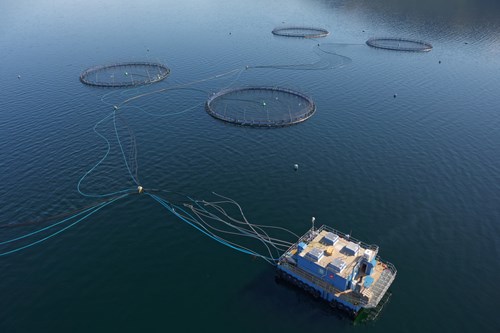
Open-net Salmon Farming
Andrew Graham-Stewart
Added on 27 March 2025
To accompany the new Scottish Aquaculture map, we are pleased to introduce a guest blog from Andrew Graham-Stewart, summarising the threat to wild salmon from open-cage/net salmon farming. Andrew was previously Director in Scotland for Salmon and Trout Conservation (now WildFish) from 2012 to 2022 and is now a consultant/advisor to WildFish.
“Over the past two decades, numbers of wild salmon in Scotland’s rivers have declined by 70%.
Open-net salmon farming is fundamentally unsustainable. Poorly run and badly sited open-net salmon farms put wild salmon and sea trout at risk from parasites (notably sea lice) and diseases.”
Source WildFish: www.wildfish.org
What is the Problem with Sea Lice?
In the west Highlands and Islands of Scotland, which play host to over 200 salmon farms (producing over 200,000 tonnes of farmed salmon annually), sea lice represent a lethal threat, almost certainly the most lethal threat, to the survival of wild salmon and sea trout.
Open-net Salmon Farms: a Breeding Ground for Sea Lice
Background levels of sea lice parasites occur naturally in the sea. However, the arrival and exponential expansion of salmon farming, particularly in fjordic or largely enclosed sea lochs, has caused a fundamental change in the density and occurrence of sea lice in the coastal waters of the west Highlands and Islands. Even one or two mature female sea lice per fish within a set of cages housing hundreds of thousands of farmed salmon amount to a very large breeding reservoir producing huge numbers of mobile juvenile sea lice that move out into the local marine environment.
The Consequences for Wild Fish
The consequences for wild salmon and sea trout smolts, the metamorphosing fragile skin of which is not adapted to cope with more than a few lice, as they migrate from local rivers to the sea, can be devastating. Lice feed by grazing on the surface of the fish and eating the mucous and skin. Large numbers of lice soon cause the loss of fins, severe scarring, secondary infections and, in time, death. Badly infested wild salmon smolts disappear out to sea, never to be seen again. In contrast, afflicted sea trout smolts remain within the locality and they, together with the impact of the deadly burdens they carry, are more easily monitored.
The Serious Implications when Farmed Salmon Escape
Farmed fish that escape threaten the genetic integrity of wild salmon and further compromise their future survival. These threats to the genetic integrity of wild salmon apply to both marine salmon farms and freshwater salmon (smolt) farms.
WildFish campaigns for the closure of all existing open-net salmon farms and robustly opposes any proposed expansion of existing farms or the establishment of new farms.
Andrew Graham-Stewart*
*The above text was originally published on WildFish (https://wildfish.org/project/salmon-farming/). Used with permission.